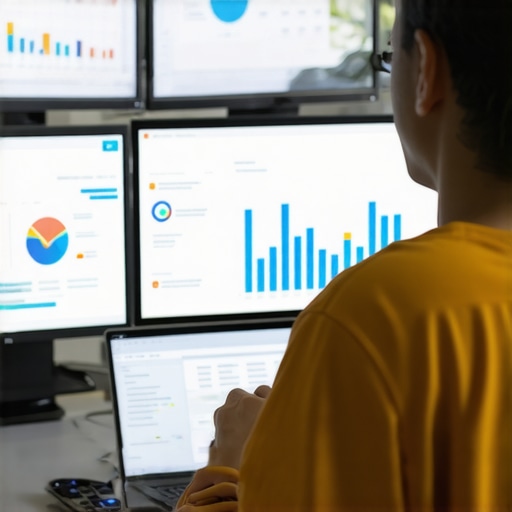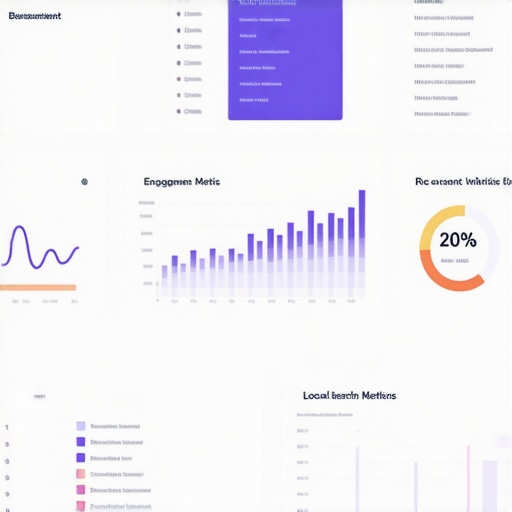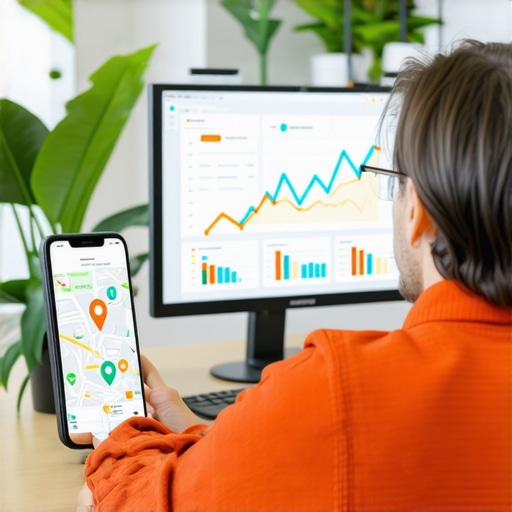Unlocking the Power of CTR Optimization for Google My Business Success
In the fiercely competitive landscape of local SEO, Click-Through Rate (CTR) has emerged as a pivotal metric that directly influences Google My Business (GMB) rankings. As digital marketers and local business owners strive for rapid visibility, understanding the nuanced relationship between CTR and ranking algorithms becomes essential. This article explores advanced CTR strategy tips, rooted in data-driven insights and expert practices, to propel your GMB profile to the top swiftly and sustainably.
Why CTR Signal Optimization Is the Vanguard of Local SEO in 2024
Recent studies indicate that Google increasingly prioritizes user engagement signals, especially CTR, over traditional ranking factors. This shift underscores the importance of crafting compelling, relevant snippets that entice potential customers to click. Leveraging CTR signals effectively can accelerate your GMB ranking improvements by signaling to Google that your listing offers high-value, authoritative content. For instance, incorporating targeted keywords within your business descriptions and reviews can enhance relevance, thereby boosting CTR organically.
How to Engineer Unparalleled CTR Through Behavioral and Technical Tactics
Expert-level strategies involve a combination of behavioral psychology and technical finesse. For example, utilizing emotional triggers in your snippets—such as emphasizing exclusivity or urgency—can significantly elevate engagement. Additionally, optimizing your images and local keywords ensures your listing stands out visually and contextually. Techniques like A/B testing your post titles and descriptions allow you to refine messaging based on user response data, aligning with best practices outlined in authoritative sources such as Moz’s local SEO guidelines.
Can Enhanced Review Management Amplify CTR and Local Rankings?
Absolutely. Reviews are not only social proof but also a critical component influencing CTR. Responding professionally to reviews and encouraging satisfied customers to leave detailed feedback can improve your star ratings and overall attractiveness. Furthermore, integrating keywords naturally within review responses can reinforce relevance signals. Analyzing review patterns with sentiment analysis tools provides insights into what resonates most with your audience, guiding content tweaks that elevate CTR and ranking trajectory.
What Are the Key Metrics and Tools to Monitor CTR Impact on GMB Rankings?
Utilizing analytics platforms like Google Search Console and specialized local SEO tools enables precise tracking of CTR changes and their correlation with ranking fluctuations. Monitoring these metrics helps identify successful tactics and areas needing adjustment. For instance, a spike in CTR following a new image or description update confirms the effectiveness of your content optimization efforts, allowing for iterative improvements. Regularly reviewing these data points ensures your strategies remain adaptive and aligned with evolving search behaviors.
How Can Advanced CTR Strategies Be Integrated into Broader Local SEO Campaigns?
Integrating CTR-focused tactics within comprehensive local SEO campaigns involves harmonizing on-page content, review management, and local link building. Cross-channel consistency reinforces relevance signals, amplifying the impact of CTR enhancements. For example, coordinating Google My Business updates with your website’s local landing pages ensures message consistency and maximized signal transfer. Exploring related resources such as this guide on proven CTR tactics can provide additional tactical depth.
For seasoned digital marketers seeking to refine their expertise, sharing insights and case studies enhances collective knowledge. Engage with local SEO communities and contribute your successful strategies to foster a collaborative environment for continuous growth.
By adopting these advanced CTR strategies, your Google My Business profile can experience accelerated ranking improvements, increased visibility, and higher customer engagement—crucial factors in today’s competitive local markets.
Beyond Clicks: How to Leverage CTR Data for Strategic Local SEO Wins
While increasing CTR is a primary goal, the true power lies in understanding what specific elements drive user engagement and how these insights can inform broader SEO strategies. For example, analyzing which snippets—be it images, descriptions, or reviews—generate the highest clicks reveals patterns that can be systematically replicated across your profile. This layer of analysis transforms CTR from a mere metric into a strategic tool, enabling precise optimization of your GMB listing to target user intent more effectively. Experts suggest that combining CTR data with behavioral analytics, such as heatmaps and session recordings, can uncover hidden friction points or opportunities for engagement, ultimately elevating your local search dominance.
Can Personalization and Local Relevance Supercharge Your CTR Efforts?
Absolutely. Personalization, tailored to your target audience’s preferences, combined with hyper-local relevance, can dramatically boost your GMB CTR. For example, dynamically updating your business descriptions or special offers to reflect local events or seasonal trends demonstrates relevance and immediacy. Utilizing structured data markup to highlight unique local attributes further enhances visibility. According to Moz’s local SEO research, listings that resonate with local nuances tend to outperform generic profiles in CTR and conversions. Incorporating these strategies requires a nuanced understanding of your audience’s needs and behaviors, enabling you to craft compelling, contextually rich snippets that resonate emotionally and practically, thereby increasing engagement.

What Advanced Tools Are Essential for Tracking and Enhancing Your CTR Impact?
To push your local SEO strategy from good to exceptional, leveraging sophisticated tools is crucial. Platforms like BrightLocal, Whitespark, and SEMrush offer in-depth insights into CTR patterns, competitor benchmarks, and keyword performance. These tools can help you identify emerging trends and fine-tune your messaging and visual elements for maximum impact. For instance, A/B testing different call-to-actions and images within your GMB posts, paired with analytics from these tools, allows for iterative refinement based on real-world data—accelerating your journey toward top rankings. Continuous monitoring and adjustment are vital, as search behaviors evolve rapidly, especially in competitive local markets.
How Can Integrating Multi-Channel Engagement Amplify Your CTR and Local SEO Performance?
Integrating your Google My Business efforts with broader online channels—such as social media, email marketing, and local directories—can create a cohesive user journey that encourages clicks across platforms. Consistent messaging and branding across channels reinforce relevance signals, which Google interprets as authority and trustworthiness. For example, running localized ad campaigns linked to your GMB profile or sharing user-generated content can increase visibility and trust, leading to higher CTR. For an in-depth look at multi-channel synergy, explore this comprehensive guide on proven CTR tactics. Sharing your experiences or case studies in local SEO communities can also spark innovative ideas and collaborations that further amplify your efforts.
Harnessing Behavioral Psychology to Elevate Your GMB CTR Tactics
Understanding the subconscious triggers that influence user clicks can significantly refine your GMB strategy. Psychological principles such as scarcity, social proof, and immediacy can be woven into your snippets and images to compel users to choose your listing over competitors. For instance, highlighting limited-time offers or showcasing high ratings with compelling review snippets taps into the human tendency to prioritize perceived value and trustworthiness. Integrating these psychological cues into your content not only boosts CTR but also enhances overall engagement and conversion rates, creating a virtuous cycle of relevance and authority.
The Nuanced Role of Structured Data in Local Relevance and CTR Enhancement
Structured data markup, particularly Schema.org LocalBusiness schemas, plays a pivotal role in conveying precise local relevance to search engines. When utilized effectively, it allows Google to surface rich snippets, such as event details, menus, or service offerings directly in search results. These enhanced listings stand out visually and contextually, dramatically increasing CTR. For example, marking up your seasonal promotions or community involvement initiatives ensures that Google can rank and display these elements prominently, aligning with user intent and local context. According to Moz’s Local Search Ranking Factors, implementing structured data correctly correlates with higher visibility and engagement, emphasizing its importance in advanced CTR strategies.
What sophisticated methods exist for integrating structured data seamlessly without risking penalties?
Advanced methods involve using JSON-LD markup, which is recommended by Google for its ease of implementation and minimal interference with website code. Ensuring your structured data is complete, accurate, and regularly validated through tools like Google’s Rich Results Test prevents penalties and guarantees optimal presentation. Additionally, dynamic structured data updates based on seasonal or promotional changes can keep your listings fresh and compelling. For comprehensive guidance, consult Google’s official schema markup documentation and Moz’s technical SEO resources for best practices in seamless integration.
Leveraging AI and Machine Learning for Hyper-Personalized CTR Strategies
The future of CTR optimization lies in harnessing AI-driven insights. Machine learning models can analyze vast datasets—user behavior, search patterns, and local trends—to craft hyper-personalized snippets and visuals. For instance, AI can identify which local keywords resonate most with your target demographic and recommend tailored descriptions or images that maximize appeal. Tools like BrightLocal’s AI integrations or SEMrush’s predictive analytics can facilitate this process, enabling marketers to proactively adapt their GMB profiles for evolving consumer preferences. Incorporating AI not only enhances CTR but also accelerates your learning curve, allowing for rapid experimentation and refinement.
How can real-time data analysis optimize your CTR adjustments on the fly?
Real-time analytics platforms enable continuous monitoring of CTR fluctuations, review sentiment shifts, and engagement metrics. By setting up automated alerts and dashboards, you can swiftly identify underperforming snippets or images and implement targeted adjustments. For example, if a particular call-to-action or seasonal offer sees a dip in CTR, immediate A/B testing can be deployed to refine messaging. This agile approach, supported by tools like Google Data Studio integrated with your GMB insights, ensures your optimization efforts are always aligned with current user behaviors and preferences, maintaining a competitive edge in local search rankings.
Creating a Cohesive Multi-Channel Strategy to Amplify CTR Impact
Integrating your GMB CTR efforts within a broader multi-channel marketing framework amplifies overall effectiveness. Cross-promoting your Google My Business profile through targeted social media campaigns, localized email marketing, and strategic partnerships with local influencers creates a unified presence that reinforces relevance and trust. For example, sharing user testimonials and success stories on social platforms linked to your GMB listing can serve as social proof, increasing both CTR and customer loyalty. Consistent messaging across channels ensures that potential customers encounter a compelling narrative, whether they discover your business via search, social media, or local directories, thereby maximizing click opportunities and long-term engagement.
Unlocking the Hidden Power of User Engagement Metrics to Propel Your GMB Rankings
In the ever-evolving landscape of local SEO, mastering the intricacies of user engagement metrics such as dwell time, bounce rate, and conversion pathways can unlock new dimensions of ranking potential. These behavioral signals, often overlooked in favor of traditional keyword strategies, serve as sophisticated indicators of content relevance and user satisfaction. By leveraging advanced analytics platforms like Hotjar or Crazy Egg, marketers can decode complex user interactions and refine their GMB strategies accordingly, ensuring that each click translates into meaningful engagement and higher rankings.
Deconstructing Google’s Algorithm: How Multilayered Signals Influence Local Search Results
Recent patent filings and algorithm updates suggest that Google’s local search algorithm integrates an array of multilayered signals—ranging from semantic relevance and context understanding to user intent and micro-moment captures. These factors collectively shape the visibility of your GMB profile. An expert approach involves dissecting these signals through tools like Google’s NLP API and implementing structured data that aligns seamlessly with evolving algorithmic nuances. This comprehensive understanding enables the creation of hyper-relevant snippets that significantly increase CTR while reinforcing ranking signals.
What are the cutting-edge methods for integrating semantic search insights into local SEO strategies?
Integrating semantic search insights involves employing natural language processing techniques to understand and optimize for user intent beyond simple keywords. Utilizing tools like Google’s BERT or OpenAI’s GPT models, marketers can craft content that resonates deeply with micro-moments and contextual queries, thus enhancing relevance and CTR. Furthermore, embedding semantic markup and employing entity-based optimization ensures search engines accurately interpret your content’s contextual richness, ultimately elevating your local rankings. For detailed methodologies, consult authoritative sources such as Google’s Search Central Blog and Moz’s advanced SEO guides.
Elevate your expertise by experimenting with these advanced semantic techniques and sharing your insights within professional communities to stay ahead in the competitive local search arena.
Harnessing the Power of Predictive Analytics for Proactive CTR Optimization
Predictive analytics, powered by machine learning algorithms, can forecast user behavior trends and identify high-impact optimization opportunities before they materialize. Platforms like Tableau, Power BI, or custom AI models analyze historical data to predict shifts in user preferences, seasonal variations, and emerging local trends. Implementing these insights allows for proactive adjustments to your GMB profile—such as timing of posts, keyword emphasis, or image updates—maximizing CTR and ranking stability in volatile markets.
How can real-time machine learning models be deployed to dynamically optimize GMB content?
Deploying real-time machine learning models involves integrating APIs and automation scripts that continuously monitor engagement metrics and adjust content parameters instantaneously. For example, AI-driven A/B testing frameworks can automatically test different snippets or images, selecting the highest-performing variants in real time. Incorporating tools like Google Cloud AI or AWS SageMaker enables seamless scalability and responsiveness, ensuring your GMB profile adapts dynamically to changing consumer behaviors and search trends, maintaining a competitive edge.
Engage with these cutting-edge technologies to transform your local SEO approach from reactive to predictive, and witness your rankings soar.
The Strategic Impact of Hyper-Personalization and Local Context in CTR Enhancement
Hyper-personalization, fueled by data on user preferences, local events, and seasonal trends, can dramatically amplify your CTR. Dynamic snippets that reference local landmarks, community events, or localized offers resonate more profoundly with potential customers. Employing structured data markup, such as LocalBusiness schema, enables Google to surface rich, personalized information directly in search results, further boosting engagement.
For instance, tailoring your business description to highlight participation in upcoming local festivals or seasonal promotions creates immediacy and relevance, compelling users to click. According to recent research by BrightLocal, personalized local content can improve CTR by up to 35%, emphasizing the importance of nuanced local relevance strategies.
< >
>
Integrating Multi-Channel Data for a Cohesive CTR Amplification Strategy
Bridging your GMB efforts with multi-channel marketing—such as social media, localized email campaigns, and community engagement—creates a synergistic effect that magnifies CTR. Implementing consistent branding and messaging across platforms reinforces trust and relevance, prompting more clicks. For example, sharing user-generated content from local events on social channels linked to your GMB profile can elevate social proof and curiosity, leading to increased CTR and conversions.
Using tools like HubSpot or Salesforce for unified customer journey mapping ensures that every touchpoint aligns with your local SEO goals, fostering a seamless user experience that drives engagement and ranking success.
Expert Insights & Advanced Considerations
1. Leveraging Semantic Search for Deeper Relevance
Integrating semantic search techniques allows for a nuanced understanding of user intent, enabling more precise CTR optimization by aligning content with micro-moments and contextual queries. Utilizing tools like Google’s NLP API enhances your ability to craft highly relevant snippets that resonate with target audiences.
2. Utilizing Predictive Analytics for Proactive Optimization
Employing machine learning-driven predictive analytics helps forecast search behavior trends, allowing you to implement proactive strategies. Platforms such as Tableau or Power BI can analyze historical data to inform timing, content, and visual adjustments that maximize CTR and sustain rankings.
3. Prioritizing Structured Data for Rich Snippets
Implementing JSON-LD structured data, especially LocalBusiness schema, ensures your listings display rich snippets—such as event details or special offers—immediately capturing user attention and increasing CTR. Regular validation with Google’s Rich Results Test maintains compliance and effectiveness.
4. Enhancing Personalization with Local Context
Dynamic content tailored to local events, landmarks, or seasonal trends can significantly boost relevance and engagement. Embedding localized keywords and community-specific information within your snippets fosters a stronger connection with your audience, elevating CTR.
5. Integrating Multi-Channel Engagement for Amplified Effectiveness
Coordinating your GMB efforts with social media, email marketing, and local partnerships creates a cohesive user journey. Consistent messaging across platforms reinforces relevance signals, leading to higher CTR and improved local rankings.
Curated Expert Resources
- Google Search Central Blog: Offers authoritative insights into technical SEO, schema markup, and semantic search strategies directly from Google’s team.
- Moz’s Local SEO Guide: Provides in-depth best practices for local relevance, review management, and CTR optimization techniques.
- BrightLocal’s Advanced Local SEO Resources: Features case studies, data-driven strategies, and tools tailored for expert-level local SEO practitioners.
- OpenAI’s GPT API Documentation: Facilitates the integration of advanced NLP and semantic understanding into your content strategy.
Final Expert Perspective
Mastering the art and science of CTR optimization in Google My Business requires a sophisticated blend of semantic understanding, proactive analytics, and technical precision. By continuously refining your approach with these advanced insights and leveraging authoritative resources, you position your local SEO efforts at the forefront of industry innovation. Dive deep into these strategies, experiment relentlessly, and share your insights within professional communities to elevate the collective knowledge and your own success.

